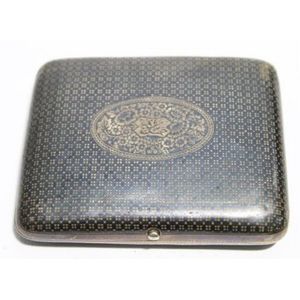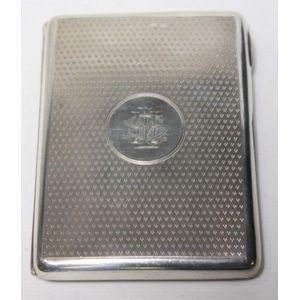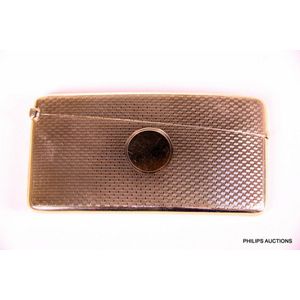Gold Engine Turned Visiting Card Case by William Neale & Son
A 9 carat gold engine turned Visiting card case, 1920 Birmingham, .375 stamp, maker's mark for William Neale & Son, the slender curved case with an angled hinged lid and vacant circular cartouche; hallmarked to the interior rim, gold weight 33gr, height 4 cm, width 8 cm
You must be a subscriber, and be logged in to view price and dealer details.
Subscribe Now to view actual auction price for this item
When you subscribe, you have the option of setting the currency in which to display prices to $Au, $US, $NZ or Stg.
This item has been sold, and the description, image and price are for reference purposes only.
- Carat - A carat (abbreviated "ct") is a unit of measurement used to describe the weight of a diamond or other gemstone, and separately is a unit of measurement used to describe the weight of precious metals such as gold,.
For gemstones, one carat is equal to 0.2 grams or 200 milligrams. The weight of a diamond is one of the Four Cs (along with cut, colour, and clarity) that are used to determine a diamond's value.
It is important to note that a diamond's weight does not necessarily correspond to its size. A diamond's cut, which affects how well it reflects light, can make a diamond of a lower weight appear larger than a diamond of a higher weight. Additionally, the carat is not the only factor to determine the value of a diamond, other factors such as clarity, colour and cut are important too.
In the gold industry, the purity of gold is measured in carats (abbreviated "ct"), with 24 karats being pure gold and lower carat numbers indicating a lower purity level. So, for example, 18 carat gold is 18/24 or 75% pure gold, and 12 carat gold is 12/24 or 50% pure gold. - Cartouche - An ornamental panel in the form of of a shield, oval or rectangular scroll with curling edges. It may be carved into the back of a chair or the top of a sideboard, or present on a piece of silver or jewellery, and contain the initials of the original owner, heraldic symbols, or some other inscription, such as the details of a presentation.
In ceramics the term defines the central area of a vase or similar with a decorative border in one of the shapes above, into which a decorative scene or figures have been painted. - Engine Turned - Engine turning is a decorative technique used on metal surfaces to create intricate curving or geometric pattern. The process involves cutting a series of lines into the surface of the metal using a rose engine or decoration lathe which rotates the metal as it cuts, allowing the operator to create a repeating pattern that covers the entire surface. The resulting surface has a shimmering, reflective quality that is often described as "engine turned." Where an engine turned item has been enamelled, the term used to describe the decoration is usually guilloche.
Engine turning was originally developed to decorate metal objects such as firearms, scientific instruments, and other metal objects that required precise and elegant design.
This item has been included into following indexes:
Visually similar items

A sterling silver cigarette case cushion shaped with engine turned hexagonal pattern. Chester 1924. Weight 97g. Length 8 cm
Sold by
in
for
You can display prices in $Au, $US, $NZ or Stg.

An Edwardian sterling silver cigarette case, engine turned motif, monogramned 'P.G', Birmingham 1928, by J. Gloster Ltd, total weight 93 g
Sold by
in
for
You can display prices in $Au, $US, $NZ or Stg.

A silver niello cigarette case, 9 x 8 cm
Sold by
in
for
You can display prices in $Au, $US, $NZ or Stg.

A hallmarked sterling silver aide memoire, Birmingham 1913, 122g
Sold by
in
for
You can display prices in $Au, $US, $NZ or Stg.
